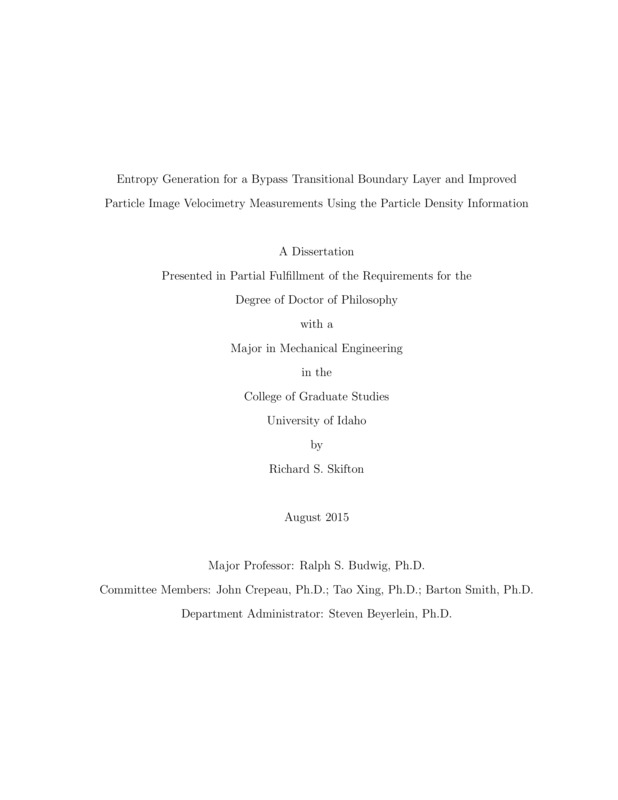Entropy Generation for a Bypass Transitional Boundary Layer and Improved Particle Image Velocimetry Measurements Using the Particle Density Information
Skifton, Richard. (2015). Entropy Generation for a Bypass Transitional Boundary Layer and Improved Particle Image Velocimetry Measurements Using the Particle Density Information. Theses and Dissertations Collection, University of Idaho Library Digital Collections. https://www.lib.uidaho.edu/digital/etd/items/skifton_idaho_0089e_10670.html
- Title:
- Entropy Generation for a Bypass Transitional Boundary Layer and Improved Particle Image Velocimetry Measurements Using the Particle Density Information
- Author:
- Skifton, Richard
- Date:
- 2015
- Program:
- Mechanical Engineering
- Subject Category:
- Mechanical engineering
- Abstract:
-
The principal purpose of this study is to better understand the pointwise entropy generation rate in bypass, transitional, boundary-layer flow. The experimental work herein, utilized particle image velocimetry (PIV) to measure flow along a flat plate. The flow past the flat plate was under the influence of a ``negligible'' zero pressure gradient; followed by the installation of an adverse pressure gradient. Further, the boundary layer flow was artificially tripped to turbulence (called ``bypass'' transition) by means of elevated freestream turbulence. The pointwise entropy generation rate was seen to behave similar to that of published CFD and DNS results. The observations from this work show the decrease of viscous contributions to entropy generation rate through the transition process; while the turbulent contributions of entropy generation rate greatly increase through the same transitional flow. A basic understanding of pointwise entropy generation rate over a flat plate is that a large majority of the contributions come within a $y^+<30$. However, a trade off between viscous and turbulent dissipation begins very early on in the flow where a significant amount of the total pointwise entropy generation rate is seen up to the wake region of the boundary layer.
An improvement to the measurement technique of PIV was found when taking measurements very near a wall interface. The particles utilized in PIV form a biased dispersion near interfaces that, in turn, lead to biased velocity measurements. This lack of seeding in the high shear region of the flow \textit{always} biases the velocity measurement high as the particles are, on average, towards the far end of an interrogation window (IW) -- opposite of the wall. By observing the ensemble-averaged IW particle-dispersion centroid as the corrected measurement location against the conventional standard of the geometric center of the IW, this paper puts forth a methodology to correct for the biased error in flow measurements very near the wall. A typical correction to the reported velocity measurement \textit{location} within a wall layer flow was seen to be approximately 75\% from the geometric center to the edge of an IW -- a significant improvement at relatively low velocities.
- Description:
- doctoral, Ph.D., Mechanical Engineering -- University of Idaho - College of Graduate Studies, 2015
- Major Professor:
- Budwig, Ralph S
- Committee:
- Crepeau, John; Xing, Tao; Smith, Barton
- Defense Date:
- 2015
- Identifier:
- Skifton_idaho_0089E_10670
- Type:
- Text
- Format Original:
- Format:
- application/pdf
- Rights:
- In Copyright - Educational Use Permitted. For more information, please contact University of Idaho Library Special Collections and Archives Department at libspec@uidaho.edu.
- Standardized Rights:
- http://rightsstatements.org/vocab/InC-EDU/1.0/

